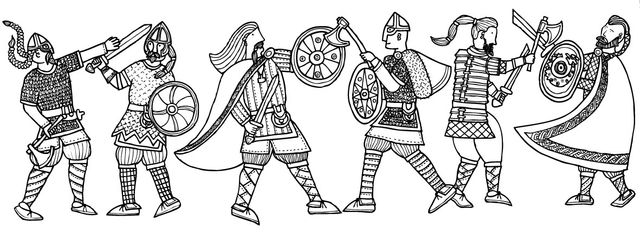2.1.14
Elizabeth I & Relations With Foreign Powers
Elizabeth I's Relations with France and Scotland
Elizabeth I's Relations with France and Scotland
Whilst consolidating her power, Elizabeth had to deal with the threat of Scotland and France.


Mary Queen of Scots and Francis II
Mary Queen of Scots and Francis II
- Elizabeth I's cousin, Mary was the Queen of Scotland.
- Mary had married Prince Francis of France.
- Following the death of Francis' father, Henry II, Mary and her husband became the rulers of France.
- However, Francis II died in 1560 and Mary returned to Scotland.


Secure the Scottish Border
Secure the Scottish Border
- Elizabeth I and her advisors wanted to make sure the border with Scotland was secure.
- This was to prevent any potential invasion by French and Scottish forces.
- In December 1559, the English navy went to the Firth of Forth (near Edinburgh) to stop French troops from landing.


The Scottish Protestant rebellion
The Scottish Protestant rebellion
- Under pressure from her advisors, Elizabeth I supported a rebellion in Scotland against Mary of Guise (the regent of Scotland).
- This rebellion was led by John Knox and Scottish noblemen, called the Lords of the Congregation.
- After successfully seizing power, these noblemen formed a parliament and reformed the Church of Scotland.
- This reduced Scotland's threat to Elizabeth I.


The Treaty of Edinburgh
The Treaty of Edinburgh
- The Treaty of Edinburgh was signed between England, Scotland and France in 1560.
- This treaty put an end to the rebellion led by the Lords of the Congregation.
- The treaty ended the Auld Alliance between Scotland and France, reducing the threat of these countries to England.
- Elizabeth I secured peace with France by signing the Treaty of Cateau-Cambresis.
- This demonstrates Elizabeth I's desire to avoid costly wars and keep peace with England's neighbours.


French Wars of Religion
French Wars of Religion
- In 1562 France was thrust into the Wars of Religion.
- This was a conflict between Catholics and Huguenots (Protestants).
- This internal fighting meant France was less of a threat to England.
Elizabeth I's Relations with Spain
Elizabeth I's Relations with Spain
King Philip II ruled Spain and the Netherlands. As a Catholic monarch, Philip was a potential threat to Elizabeth I.


Philip II's ban of English clothing imports
Philip II's ban of English clothing imports
- The Netherlands was a vital trading partner with England.
- In 1563, Philip II banned English cloth imports to the Netherlands.
- This damaged England's economy.


Reasons for the ban
Reasons for the ban
- This ban was supposedly meant to protect the Netherlands against infection from England.
- However, in reality it was a reaction against England's growing power in their trading relationship. It may also have been in response to Elizabeth ignoring the Protestant messages English merchants were spreading to the Dutch people.


Elizabeth's response
Elizabeth's response
- Elizabeth also banned dutch imports.
- By 1564, both bans were lifted and trade relations returned to normal.


The treaty of Spain
The treaty of Spain
- Although Elizabeth tried to maintain peace with Philip II, she was aware of the threat he posed.


Historical assessment
Historical assessment
- Elizabeth's cautious foreign policy has been criticised by historians and was a source of frustration for many of her contemporaries.
- Historian G.D. Ramsay (2000) argues: 'To dignify the dealings of Elizabeth Tudor and her continental neighbours with the title of "foreign policy" perhaps suggests more than her often hesitant groping could substantiate.'
- Ramsay (2000): 'Her objectives were prosaic and local but practicable.' Elizabeth saw off the Armada and built her economy through the cloth-export trade.
1Consolidation of the Tudor Dynasty 1485-1547
1.1Henry VII 1485-1509
1.1.1Henry VII's Consolidation of Power
1.1.2Henry VII & Succession
1.1.3Henry VII's Councils & Parliament
1.1.4End of Topic Test - Henry VII Part 1
1.1.5Henry VII & Justice, Finance & Policies
1.1.6Henry VII's Relationship with Foreign Powers
1.1.7Henry VII & Society
1.1.8End of Topic Test - Henry VII Part 2
1.1.9Henry VII & Regional Issues
1.1.10Henry VII & Economic Development
1.1.11Henry VII & Cultural Development
1.1.12End of Topic Test - Henry VII Part 3
1.2Henry VIII 1509-1547
1.2.1Henry VIII's Consolidation of Power
1.2.2Henry VIII & His Government
1.2.3Henry VIII & His Government 2
1.2.4End of Topic Test - Henry VIII Part 1
1.2.5Henry VIII & Succession
1.2.6Henry VIII's Relationship with Foreign Powers
1.2.7Henry VIII & Society
1.2.8End of Topic Test -Henry VIII Part 2
1.2.9Henry VIII & Society 2
1.2.10Henry VIII & Economic Development
1.2.11Henry VIII & Religion
1.2.12End of Topic Test - Henry VIII Part 3
2England: Turmoil & Triumph 1547-1603
2.1Instability & Consolidation 1547-1563
2.1.1Edward VI, Somerset & Northumberland
2.1.2Edward VI & Authority
2.1.3Edward VI & Relations with Foreign Powers
2.1.4End of Topic Test - Edward VI Part 1
2.1.5Edward VI & Rebellions
2.1.6Social Impact of Religious & Economic Changes
2.1.7Edward VI & Cultural Developments
2.1.8End of Topic Test - Edward VI Part 2
2.1.9Mary I & Her Rule
2.1.10Mary I & Relations with Foreign Powers
2.1.11The Social Impact of Religious & Economic Change
2.1.12End of Topic Test - Mary Part 1
2.1.13Elizabeth I & Her Rule
2.1.14Elizabeth I & Relations With Foreign Powers
2.1.15Impact of Economic, Social & Religious Change
2.1.16End of Topic Test - Elizabeth I Part 1
2.2The Triumph of Elizabeth 1563-1603
2.2.1Elizabeth I & Court
2.2.2Elizabeth & Government
2.2.3Elizabeth I & Succession
2.2.4End of Topic Test - Elizabeth I Part 2
2.2.5Mary Queen of Scots
2.2.6Relations with Spain
2.2.7End of Topic Test - Elizabeth I Part 3
2.2.8Elizabeth I & Society
2.2.9Elizabeth I & Rebellion
2.2.10Elizabeth & Economic Development
2.2.11End of Topic Test - Elizabeth I Part 4
2.2.12Elizabeth I & Religious Developments
2.2.13The English Renaissance
2.2.14Elizabeth's Last Years
2.2.15End of Topic Test - Elizabeth I Part 5
Jump to other topics
1Consolidation of the Tudor Dynasty 1485-1547
1.1Henry VII 1485-1509
1.1.1Henry VII's Consolidation of Power
1.1.2Henry VII & Succession
1.1.3Henry VII's Councils & Parliament
1.1.4End of Topic Test - Henry VII Part 1
1.1.5Henry VII & Justice, Finance & Policies
1.1.6Henry VII's Relationship with Foreign Powers
1.1.7Henry VII & Society
1.1.8End of Topic Test - Henry VII Part 2
1.1.9Henry VII & Regional Issues
1.1.10Henry VII & Economic Development
1.1.11Henry VII & Cultural Development
1.1.12End of Topic Test - Henry VII Part 3
1.2Henry VIII 1509-1547
1.2.1Henry VIII's Consolidation of Power
1.2.2Henry VIII & His Government
1.2.3Henry VIII & His Government 2
1.2.4End of Topic Test - Henry VIII Part 1
1.2.5Henry VIII & Succession
1.2.6Henry VIII's Relationship with Foreign Powers
1.2.7Henry VIII & Society
1.2.8End of Topic Test -Henry VIII Part 2
1.2.9Henry VIII & Society 2
1.2.10Henry VIII & Economic Development
1.2.11Henry VIII & Religion
1.2.12End of Topic Test - Henry VIII Part 3
2England: Turmoil & Triumph 1547-1603
2.1Instability & Consolidation 1547-1563
2.1.1Edward VI, Somerset & Northumberland
2.1.2Edward VI & Authority
2.1.3Edward VI & Relations with Foreign Powers
2.1.4End of Topic Test - Edward VI Part 1
2.1.5Edward VI & Rebellions
2.1.6Social Impact of Religious & Economic Changes
2.1.7Edward VI & Cultural Developments
2.1.8End of Topic Test - Edward VI Part 2
2.1.9Mary I & Her Rule
2.1.10Mary I & Relations with Foreign Powers
2.1.11The Social Impact of Religious & Economic Change
2.1.12End of Topic Test - Mary Part 1
2.1.13Elizabeth I & Her Rule
2.1.14Elizabeth I & Relations With Foreign Powers
2.1.15Impact of Economic, Social & Religious Change
2.1.16End of Topic Test - Elizabeth I Part 1
2.2The Triumph of Elizabeth 1563-1603
2.2.1Elizabeth I & Court
2.2.2Elizabeth & Government
2.2.3Elizabeth I & Succession
2.2.4End of Topic Test - Elizabeth I Part 2
2.2.5Mary Queen of Scots
2.2.6Relations with Spain
2.2.7End of Topic Test - Elizabeth I Part 3
2.2.8Elizabeth I & Society
2.2.9Elizabeth I & Rebellion
2.2.10Elizabeth & Economic Development
2.2.11End of Topic Test - Elizabeth I Part 4
2.2.12Elizabeth I & Religious Developments
2.2.13The English Renaissance
2.2.14Elizabeth's Last Years
2.2.15End of Topic Test - Elizabeth I Part 5
Unlock your full potential with Seneca Premium
Unlimited access to 10,000+ open-ended exam questions
Mini-mock exams based on your study history
Unlock 800+ premium courses & e-books